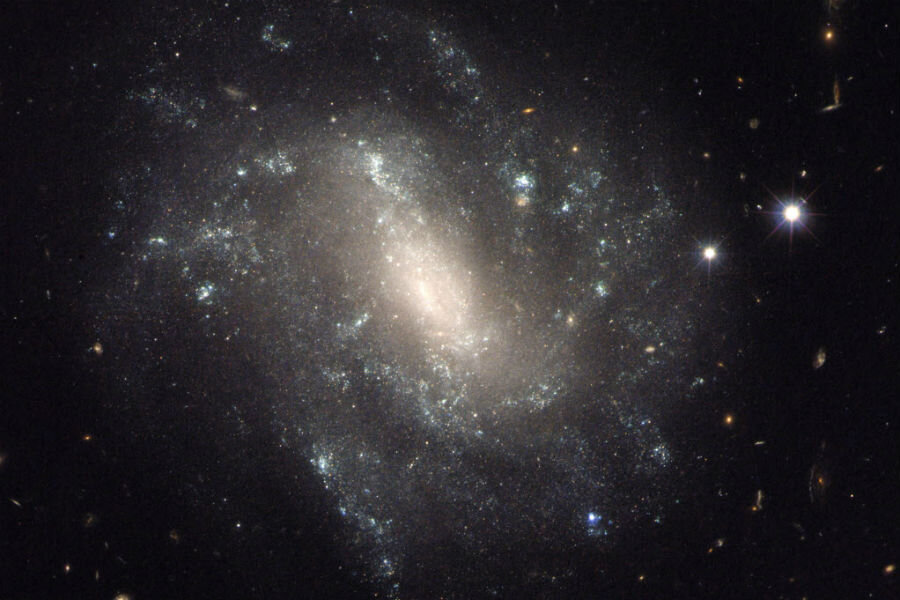Scientists create vast 3-D map of universe, validate Einstein's theories
Loading...
Hundreds of scientists worked together to map out one-quarter of the sky – and they weren't just plotting landmarks for a road trip to Alpha Centauri.
Through painstaking, complex measurements that reached into the earliest chapters of the universe, they charted a 3-D model of 650 billion cubic light years of space that included 1.2 million galaxies. It was created with an important goal – to measure dark energy.
When scientists recently discovered that the expansion of the universe was accelerating, dark energy was suggested as the “anti-gravity” force responsible for it, perhaps even as the “cosmological constant” that Einstein envisioned. Another theory argued that gravity itself was breaking down – not particularly encouraging in a universe thought to be ruled by its laws.
Results from this massive project, however, have affirmed the laws of gravity and general relativity on a universal level, providing evidence that dark energy is indeed responsible for the accelerated expansion of the universe. The research indicated that this energy is consistent with Albert Einstein’s suggestion of Lambda, a cosmological constant that is a repellent force countering attraction between matter.
Mapping the universe
The map is based on data collected over the course of a decade by scientists from several institutions affiliated with the Sloan Digital Sky Survey III’s Baryon Oscillation Spectroscopic Survey (BOSS), a project that draws on the lasting impact of acoustic waves that undulated through the early universe.
Apart from the feat of using such measurements to depict the structure of the universe, the map has pivotal implications both for understanding how the expansion of the universe works and validating existing theories of cosmology.
The measurements for the map were made by determining the size of baryonic acoustic oscillations, or pressure waves that permeated the universe circa 400,000 years post-Big Bang. These waves left an imprint on the matter distribution of the universe and contributed to galaxies being separated by a characteristic distance, which scientists call the BAO scale. Using observations of the cosmic microwave background, scientists can detect what that primordial scale was, giving them a point of reference.
"Measuring the acoustic scale across cosmic history gives a direct ruler with which to measure the Universe’s expansion rate,” said Dr. Ariel Sanchez of the Max-Planck Institute of Extraterrestrial Physics in a press release. “With BOSS, we have traced the BAO’s subtle imprint on the distribution of galaxies spanning a range of time from 2 to 7 billion years ago."
Dr. Sanchez makes it sound simple, but it wasn't.
The scientists also had to account for the movements of the galaxies away from us in their measurements, and for the fact that the further away a galaxy is, the faster away from us it will move, which meant that scientists had to develop a model for galaxy distribution that took into account “the so-called redshift space distortion,” as Dr. Shun Saito from the Max Planck Institute for Astrophysics explained.
Different researchers used different methods to analyze the BOSS data, which were then compared. Another method set aside “prior assumptions about the cosmological model,” says Dr. Salvador Salazar-Albornoz of the Max Planck Institute for Extraterrestrial Physics.
As scientists carefully took these variables into account and compared their data, they were not just measuring three-dimensional distances between objects we can see, but the amount of dark matter and dark energy that also fills the universe – two features that remain mysterious but appear to dictate much about how the universe is shaped and will continue to expand – as this research further confirms.
When the overall picture was constructed, they found their results to be consistent with standard cosmology, or the set of theories that essentially date our universe to 13 billion years ago when the Big Bang set matter into a rapid inflation, before cooling to temperatures able to sustain the formation of atoms.
This ordinary matter, built from protons, neutrons, and electrons, comprises only about 5 percent of the universe. The remainder, the theory posits, is part dark matter – slow-moving mass that helps structure the universe – and dark energy, which makes up 70 percent of the universe.
In addition, the findings indicate that if dark energy is the driving force of universal expansion, it is evolving very slowly. “The change is at most 20 percent over the past seven billion years,” said Dr. Florian Beutler at the University of Portsmouth, reported Phys.org.
Finding consistency over billions of years
While the new map is just one step amid a universe of questions, it has helped scientists draw a clear line from the Big Bang to the formation of structures that we see in the universe today.
"We see a dramatic connection between the sound wave imprints seen in the cosmic microwave background 400,000 years after the Big Bang to the clustering of galaxies 7-12 billion years later,” Dr. Rita Tojeiro, of the University of St. Andrews, a partner in the project, told Phys.org. "The ability to observe a single well-modeled physical effect from recombination until today is a great boon for cosmology."
And looking to the future of the expansion and shape of the universe, the work also lays a groundwork for further measurement of dark energy and exploration of its effect on the expansion of the universe.
"BOSS has marked an important cosmological milestone, combining precise clustering measurements of an enormous volume with extensive observations of the primary cosmic microwave background to produce a firm platform for the search for extensions to the standard cosmological model,” astronomer Jeremy Tinker of New York University told Phys.org.
"We look forward to seeing this program extended with the coming decade of large spectroscopic surveys."







